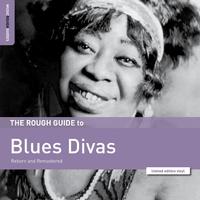Various Artists - Rough Guide To Blues Divas
| Label: |
World Music Network |
| Genre: |
Female Vocalists |
| Product No.: |
AWMN 1392
|
| UPC: | 605633139242 |
| Availability: |
In Stock
|
| Category: |
Vinyl Record |
The 1920s "classic era" of recorded blues was dominated by women who lived and performed in the cities. This Rough Guide explores its glitzy heyday when singers such as Bessie Smith and Ma Rainey became the first real stars of the blues.
For many, the stereotypical image of the early recorded blues performer is that of a black itinerant bluesman, guitar in hand, playing in a rural landscape such as the Mississippi Delta. This perception however is slightly wide of the mark, as the first blues songs recorded were by women.
The "classic blues" era of the 1920s was born when Okeh Records took Mamie Smith into a New York studio in 1920 to cut Perry Bradford's "Crazy Blues," making her the first black blues singer ever recorded and "America's First Lady of the Blues." Although not a great blues recording, it was a huge hit which sent rival record labels scrambling to discover other black female singers in order to jump on the bandwagon and replicate its success. Mamie Smith was soon to be eclipsed by other more illustrious female blues singers such as Ma Rainey and Bessie Smith, but she was the one who originally alerted the American record industry to the fact that there was a black audience for gramophone records which in turn spawned the concept of "race records."
The 1920s "classic era" of recorded blues was dominated by women who lived, performed, and recorded in the cities, even if, like Ma Rainey, they brought a country feel to their music. This first wave of female artists developed a tradition which had previously only been transmitted through local folk culture and transformed it into a performing art which appealed to the broader public. Like their male counterparts, the lyrics related to real life issues often weighing on the singer's mind such as loneliness, poverty, injustice, love and sex. The hokum craze of innuendo is apparent on several of the featured tracks, showing a side to the blues that was salacious and light-hearted.
Although performers such as Ma Rainey and Bessie Smith remained popular into the 1930s, by 1928 the golden days of the blues diva were waning largely due to the success of the recordings of Blind Lemon Jefferson and other itinerant male blues singers who were proliferating across the Deep South. The stock market crash in 1929 and ensuing Great Depression dealt a final blow which ended the careers of most of the featured singers, however during the 1960s there was a revival of interest which brought some of the featured performers including Sippie Wallace, Alberta Hunter, Edith Wilson and Victoria Spivey back to the stage.
| Side 1 | 1. Black Eye Blues – Ma Rainey | 2. Sweet Georgia Brown – Ethel Waters | 3. Salty Dog – Clara Smith | 4. Jenny’s Ball – Mamie Smith | 5. Dope Head Blues – Victoria Spivey | 6. Every Mess Around – Alberta Hunter | Side 2 |
1. Nobody Knows You When You’re Down And Out – Bessie Smith | 2. My Man Is Good For Nothing But Love – Edith Wilson | 3. Give Me A Break Blues – Ida Cox | 4. Tired As I Can Be – Lucille Bogan | 5. Shake Your Cans – Lucille Bogan | 6. I’m A Mighty Tight Woman – Sippie Wallace | 7. Bye Bye Baby – Hattie Burleson |
|
View other items by Various Artists |
|
 In-Stock Music Orders Over $99 SHIP FREE Within The Continental U.S.
In-Stock Music Orders Over $99 SHIP FREE Within The Continental U.S.







 Login
Login
 My Account
My Account
 Cart
Cart Wishlist
Wishlist
 Contact
Contact





